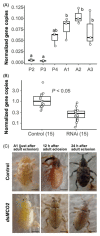New Gall-Forming Insect Model, Smicronyx madaranus: Critical Stages for Gall Formation, Phylogeny, and Effectiveness of Gene Functional Analysis
- PMID: 38249069
- PMCID: PMC10816246
- DOI: 10.3390/insects15010063
New Gall-Forming Insect Model, Smicronyx madaranus: Critical Stages for Gall Formation, Phylogeny, and Effectiveness of Gene Functional Analysis
Abstract
The molecular mechanisms underlying insect gall formation remain unclear. A major reason for the inability to identify the responsible genes is that only a few systems can be experimentally validated in the laboratory. To overcome these problems, we established a new galling insect model, Smicronyx madaranus. Our manipulation experiments using nail polish sealing and insecticide treatment revealed an age-dependent change in gall formation by S. madaranus; adult females and larvae are responsible for gall induction and enlargement, respectively. Furthermore, it has been suggested that substances released during oviposition and larval feeding are involved in each process. Phylogenetic analysis showed that gall-forming weevils, including S. madaranus, belong to two distinct lineages that utilize different host plants. This may indicate that gall-forming traits evolved independently in these Smicronyx lineages. The efficacy of RNA interference (RNAi) in S. madaranus was confirmed by targeting the multicopper oxidase 2 gene. It is expected that the mechanisms of gall formation will be elucidated by a comprehensive functional analysis of candidate genes using RNAi and the S. madaranus galling system in the near future.
Keywords: RNA interference; field dodder; insect gall; manipulation of galling insect; phylogeny of the genus Smicronyx.
Conflict of interest statement
The authors declare no competing interests, financial or otherwise.
Figures




Similar articles
-
A new galling insect model enhances photosynthetic activity in an obligate holoparasitic plant.Sci Rep. 2021 Jun 21;11(1):13013. doi: 10.1038/s41598-021-92417-3. Sci Rep. 2021. PMID: 34155293 Free PMC article.
-
Metabolic and functional distinction of the Smicronyx sp. galls on Cuscuta campestris.Planta. 2018 Sep;248(3):591-599. doi: 10.1007/s00425-018-2926-6. Epub 2018 May 28. Planta. 2018. PMID: 29808234
-
Conflicting Dynamics of Galling and Pollination: Arastichus gallicola (Hymenoptera, Eulophidae), a Specialized Parasitic Galler in Pistillate Flowers of Thaumatophyllum bipinnatifidum (Araceae).Plants (Basel). 2024 Dec 17;13(24):3520. doi: 10.3390/plants13243520. Plants (Basel). 2024. PMID: 39771218 Free PMC article.
-
Insect-induced effects on plants and possible effectors used by galling and leaf-mining insects to manipulate their host-plant.J Insect Physiol. 2016 Jan;84:70-89. doi: 10.1016/j.jinsphys.2015.12.009. Epub 2015 Dec 23. J Insect Physiol. 2016. PMID: 26723843 Review.
-
Eavesdropping on gall-plant interactions: the importance of the signaling function of induced volatiles.Plant Signal Behav. 2019;14(11):1665454. doi: 10.1080/15592324.2019.1665454. Epub 2019 Sep 20. Plant Signal Behav. 2019. PMID: 31538533 Free PMC article. Review.
Cited by
-
Parasitic-Plant Parasite Rewires Flowering Pathways to Induce Stem-Derived Galls.Plant Direct. 2025 Aug 20;9(8):e70099. doi: 10.1002/pld3.70099. eCollection 2025 Aug. Plant Direct. 2025. PMID: 40842965 Free PMC article.
References
-
- Redfern M. Plant Galls. Collins; London, UK: 2011.
-
- Shorthouse J.D., Rohfritsch O. Biology of Insect-Induced Galls. Oxford University Press; New York, NY, USA: 1992.
-
- Price P., Fernandes G., Waring G. Adaptive nature of insect galls. Environ. Entomol. 1987;16:15–24. doi: 10.1093/ee/16.1.15. - DOI
-
- Stone G.N., Schönrogge K. The adaptive significance of insect gall morphology. Trends Ecol. Evol. 2003;18:512–522. doi: 10.1016/S0169-5347(03)00247-7. - DOI
-
- Dawkins R. The Extended Phenotype. Oxford University Press; Oxford, UK: 1982.
Grants and funding
LinkOut - more resources
Full Text Sources

